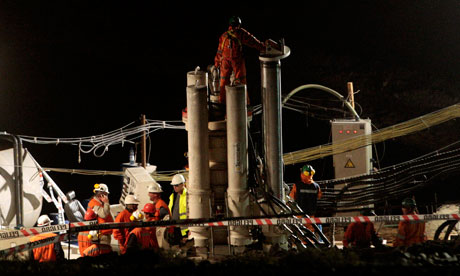Chilean miners await rescue as drilling begins
![]()
Chilean miners await rescue as drilling begins
Drill bores 50ft into rock as rescue mission to save 33 trapped miners gets under way
Jonathan Franklin in Santiago

Drilling to rescue the 33 Chilean miners trapped underground began yesterday as it emerged that they have spoken for the first time to family members waiting for them on the surface.
A 31-tonne drill bored 50ft into the rock – the first step in the week-long drilling of a “pilot hole” to guide the way for the rescue.
Later, the drill will be fitted with larger bits to widen the bore and eventually pull the men through, a process that could take three to four months.
The trapped men were able to speak briefly to family members by phone late yesterday, giving a measure of reassurance to those above as to their ability and resolve to survive until the rescue operation can free them.
“The families have had the chance to communicate by telephone with them, so of course there have been moments of great emotion,” Ximena Matas, the governor of the Atacama region, said.
The families had “listened with great interest and they both felt and realised that the men are well”, she said. “This has been a very important moment, which no doubt strengthens [the miners’] morale.”
Families took the first of what are intended to be daily phone calls in a cabin set up alongside one of the three boreholes connecting the miners with the surface.
Portions of the calls were made public, including a promise by miner Esteban Rojas that he would marry his girlfriend of 25 years when he has been rescued from the collapsed tunnel.
Because the phone connection is precarious, families were given only 20 to 30 seconds to say hello and deliver short messages.
“I could hear him fine,” Jessica Cortes, who spoke to her husband, Victor Zamora, said. “He is aware the rescue is not going to happen today, that it will take some time. He asked us to stay calm, as everything is going to be OK. “He sounded relaxed and since it was so short I didn’t manage to ask anything. Twenty seconds was nothing.”
Zamora only came to the mine after losing his job when the earthquake that hit Chile in February destroyed his workplace in Talcahuano,
He moved hundreds of miles north to get work at the San José mine. “He’s a vehicle mechanic and doesn’t even go in the mine,” Cortes said. “He went in that day because a vehicle broke down [deep] inside the mine … at first they told us he’d been crushed [to death].”
The talks by phone follow a new video showing the miners in good spirits, although many shed tears as they sent messages to their families.
“I’m sending my greetings to Angelica. I love you so much, darling,” said Osman Araya, 30, his voice choking. “Tell my mother, I love you guys so much. I’ll never leave you, I will fight to the end to be with you.”
Tomorrow, the miners enter day 26, passing the benchmark set by three Chinese miners who last year spent 25 days drinking contaminated water and chewing coal to survive in a flooded mine in Guizhou province.
The Chileans are expected to be trapped for up to 16 weeks.
Vaccinations have been given to the men to guard against tetanus and diphtheria. But skin problems, poor ventilation and humidity continue to take their toll on the health of the trapped men.
Related Articles
Confebask asume que la reforma “no se ha hecho de forma amigable”
![]()
La secretaria general de la Confederación Empresarial de la CAV, Nuria López de Gereñu, ha admitido que la reforma laboral
MAS ALLÁ DEL CORONAVIRUS – NEWSORUND/4
![]()
Acuerdo estratégico de Renault, Nissan y Mitshubishi apuntan a un repartición de mercados con fuerte reducción de puestos de trabajo
Kazakhstan: Migrant Tobacco Workers Cheated, Exploited
![]()
A Kyrgyz child whose family has travelled to work on a tobacco farm near the village of Dostyk, Kazakhstan.© 2009


